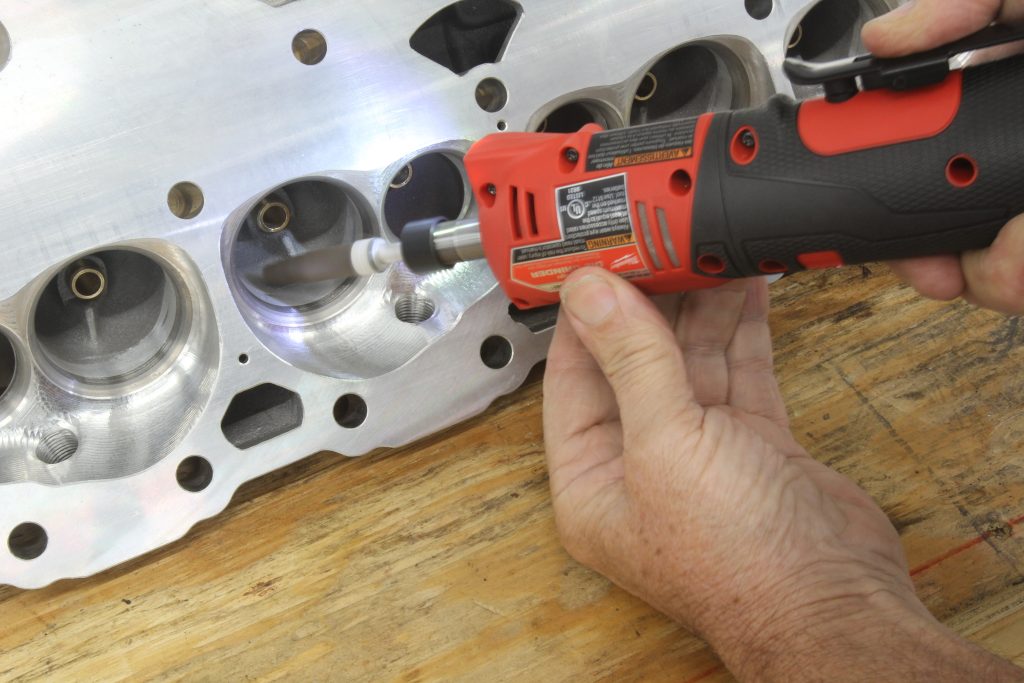We recently added more work space to our shop. While we enjoy the luxury of having sufficient room, the need to route new air lines for pneumatic tools into and around the addition didn’t sound like fun. This is when we realized that over the last couple of years, we’ve been minimizing the use of air-driven tools in favor of more convenient and less cumbersome cordless versions.
Our cordless conversion started when a friend introduced us to a slick Milwaukee 3/8-inch drive ratchet. It became our new favorite tool—it’s light, easy to maneuver, and doesn’t need a heavy, cumbersome air line. The first time I used it, I immediately had to have one of my own—and now own two. This pushed me to invest in more Milwaukee tools, mainly so I could use one charging station to keep the batteries energized.
This also led us to wonder if going cordless would be perfect for someone setting up their first shop. Don’t get us wrong. There will always be a need for compressed air for inflating tires, running heavy duty impact guns and drills, spraying paint, and other jobs that require a lot of power.
But consider this scenario: You are a younger hot rodder with a limited budget. The car wants all kinds of expensive parts, but you also need tools to screw all that stuff together. Going cordless is a fairly inexpensive option to get the tools needed to tackle most jobs around the shop. You can add air tools and a compressor as your car-crafting skills improve and project requirements increase. The idea is to maximize your investment.
The Best Mix
So what mix of cordless, air, and even corded tools is ideal? That depends on what your needs are, of course. We’ve put together a list of tools that can tackle most every job a home shop would encounter. You don’t need to get everything at once—start with the basics and add to your collection as the need arises.
Cordless Tools
• 3/8-inch ratchet
• 3/8-inch impact
• 1/2-inch impact
• 1/4-inch impact
• 1/4-inch collet die grinder
• Right angle, short reach drill
• Metal cutting circular saw
• Small reciprocating saw
• Sheetmetal nibbler
• Small cut-off tool
• Paint buffer
• Small vacuum
• Portable air compressor
• Handheld, underhood, and other LED lighting
Air Tools
• 1/2-inch impact
• 3/8-inch ratchet
• 1/4-inch die grinder
• Right angle drill
• Sander
• Paint gun
• Paint buffer
• Air nozzle
Corded Electric Tools
• 1/2-inch drill
• Paint buffer
• Bench grinder/wire wheel/sander
• Right angle grinder
About Those Batteries
Most cordless tools on the market run on batteries rated at 18 to 20 volts. They offer a lot of power and quick recharging times. A 20-volt impact gun will generally offer more torque than a 12-volt version. This is one case where more is better.
Another side of the battery power question is something called the amp-hour (ah) rating. For example, Milwaukee offers its REDLITHIUM M18 18-volt batteries rated at 3.0, 5.0, 6.0, and even 12.0 ah. The difference is the capacity of the battery for storing amperage that can be delivered over a given period of time.
Batteries with higher ah ratings offer more storage capacity than lower-rated batteries. They’re also larger, more expensive, and take longer to recharge. What you get in return is a battery that will generally deliver more power over a longer working period. This is a very generalized statement but several on-line testing sites support this evaluation.
As an example, let’s say we have an 18-volt drill that demands one amp per hour. If we power this tool with a 5ah battery, we can expect this drill to operate for five hours. If we powered a tool demanding four amps with a battery rated at 8ah, we could expect the tool to function for nearly two hours.
These examples are based on ideal conditions that rarely exist in the real world, but they give you an idea of how long you can expect batteries to last. The best way to minimize downtime is using having an extra battery or two on a charger ready to go.
Let’s take a look at some of the tools we use in our shop.












I’ve got both and use both.
Air tools I’ve had and used since the 60’s and in that period have replaced one 3/8″ air rachet and one 1/2″ drive impact gun.
I’ve had electric for 10 years, all of it Milwaukee. The main advantage for me is portability. Not everyone has compressed air for you to use but you can take spare batteries along and a charger.
The lack of hose allows an ease of motion and access in tight areas. Noise may also be a factor.
There are downsides,
Number one is the batteries. I’ve found they don’t last and are damn expensive to replace. The larger the battery the longer the service life from my experience. I can’t say that the price or nationality of the battery makes a difference. Over time I’ve ended up with three charging stations and I recharge the batteries after every use.
Number two is torque. I’ve found that air is better on rusted together bits. This or course varies with tank pressure (150PSI).
Number three, weight. The battery weight added to the tool makes for cumbersome operation one armed.
Price wise the electric tool is definitely more. If you don’t have a compressor and lines, maybe not. But, air can be handy for inflating tires easily, blowing off water and dust and other items. In the case of battery, you still need a compressor.
I should point out that running lines from the air compressor is child’s play. We use splitters to loop the lines and have four reels. This is regular rubber pressure hosing and as I mentioned we run 150PSI. The splitters have four leads making additions easy.